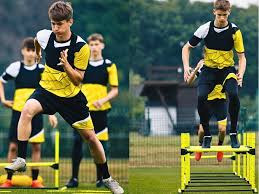More Than Speed: How Agility Training Transforms Athletes from Good to Great
Agility drills are often seen as simple tools to improve speed and change of directionbut their true impact runs much deeper. Whether it’s a footballer weaving past defenders, a tennis player reacting to a drop shot, or a basketball guard breaking through a press, agility training is the unseen force behind elite-level reactions, balance, and body control.
While athletes and coaches commonly use agility drills to boost quickness, the hidden benefits go beyond the stopwatch.
1. Enhanced Neural Efficiency and Reaction Time
Agility drills sharpen the nervous system, making the body react faster and more efficiently to unpredictable movements. Through cone drills, ladder work, and reaction-based tasks, athletes train the brain-muscle connection.
This leads to quicker decisions and sharper reactions under pressurecrucial in fast-paced sports environments where split-second timing can make or break a play.
2. Injury Prevention Through Better Movement Mechanics
One of the most underrated benefits of agility drills is injury prevention. Properly designed drills teach athletes how to decelerate, change direction safely, and maintain joint alignment under stress. This reduces the risk of common sports injuries like ACL tears, ankle sprains, and hamstring pulls. By reinforcing proper movement patterns, agility training builds durability alongside performance.
3. Improved Core Stability and Balance
Agility isn’t just about footwork it demands coordination across the entire body. Drills that involve sudden stops, pivots, and multidirectional movement challenge the core muscles to stabilize the torso. Over time, this improves balance, posture, and body control. Athletes become more grounded and fluid in their movement, which translates to better performance on the field or court.
4. Boosted Cognitive Function and Decision-Making
Agility drills often require athletes to process visual cues, auditory signals, or partner movements. This multi-sensory challenge activates the brain’s decision-making centers, improving focus and situational awareness. Sports are as much mental as physical, and agility training bridges that gap especially in team sports where reading opponents and making quick choices is critical.
5. Increased Athletic Confidence
There’s a psychological edge to mastering agility. When athletes feel quick, in control, and reactive, they gain confidence in their movements. This confidence translates into more assertive play, better anticipation, and a stronger overall presence in competition. Agility drills build trust in one’s own body.
*Agility Is the Athlete’s Secret Weapon*
Agility training is not just a warm-up or a speed booster it’s a foundational element that enhances multiple layers of athletic performance. From neurological sharpness to injury resilience and mental clarity, agility drills offer hidden benefits that set elite athletes apart. In a game of inches and milliseconds, these advantages make all the differences.

